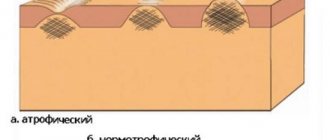Many people perceive mole removal as a simple cosmetic procedure. In reality, everything is not so simple. The formations on the skin are an accumulation of a unique pigment, melanin. Violation of its synthesis leads to the formation of colored marks on different parts of the human body. This phenomenon is quite natural and in most cases does not cause concern to a person. However, if you decide to remove nevi, you must do it correctly so as not to disrupt the normal course of processes in the body.
What is a mole?
The term "mole" is not a professional one. Medical professionals use the word “nevus” and define its meaning as congenital or acquired abnormalities in the development of the skin.
Congenital pigment spots are observed quite rarely. Nevi become noticeable and their number increases during puberty. This indicates a connection between the formation of moles and hormonal status.
Moles in medicine are called nevi
The intermediate part of the pituitary gland produces melanotropic hormone (melanotropin), which is involved in the synthesis of the melanin pigment. The pituitary gland is an important part of the endocrine system. Therefore, the statement that hormonal levels are associated with the intensity of mole formation is true.
Important! Exposure to sunlight can stimulate the formation of nevi. People with fair skin are more susceptible to pigmentation in the form of a nevus, and dark-skinned people are less susceptible.
During periods accompanied by natural hormonal changes (adolescence, pregnancy, menopause), the size and number of moles increase. The appearance of a nevus may change throughout life. The cause of degeneration is mechanical trauma in areas of frequent contact of the skin with clothing. In such or similar situations, the question arises: “Is there a need to remove a mole?” “Where and how is the best way to do this?”
Moles often occur due to hormonal changes
General characteristics of formations
Moles are brown pigmented growths. They are formed as the human body grows and develops. Additional factors for the appearance of nevi are hormonal levels, exposure to ultraviolet radiation, and genetics. Each mole contains melanin, a complex pigment that is responsible not only for color, but also for protecting the skin from sunlight.
Content:
- General characteristics of formations
- Types of nevi
- In what cases is it necessary to remove a mole?
- Contraindications to the procedure
- What you need to know about laser surgery?
- How is the removal done?
- Recovery period
- Possible complications and side effects
Most moles on the human body are not dangerous. The main thing is not to injure them, use sun filters and regularly conduct self-examination. But some pigmented formations can degenerate into melanoma. This is a malignant tumor that develops from melanocyte cells.
Melanoma is characterized by a rapid growth rate (cells rapidly divide and launch metastases throughout the body). The result is damage to organs and systems, which leads to irreversible consequences and death.
Is it possible to avoid melanoma? Yes, it is enough to conduct a self-examination and visit a dermatologist if one of the moles is suspicious. The only caveat is that melanoma cannot be removed using a laser. For this purpose, only surgical excision is used. If you notice that one of your moles has changed in color, size, or structure, contact your dermatologist immediately.
In what cases are moles removed?
The question of removing a nevus is usually resorted to when the pigment spot increases in size, becomes injured, and causes discomfort. Sometimes patients come in because of pain.
Moles are classified according to their qualities: size, color (shades of brown), clarity of contours, presence of hairs. Sometimes a mole is characterized by its volume - it can be flat or protrude above the skin.
Moles are classified differently
Based on the above signs, tactics are determined in relation to the nevus.
The category of pigmented neoplasms that are not dangerous in terms of malignancy include moles with the following signs:
- uniform color that does not change over time;
- there may be hairs on the surface;
- radius no more than 0.5 cm.
Harmless moles usually have a diameter of no more than 0.5 cm
We list the signs for which you should be observed by a dermato-oncologist at least once every six months:
- color change;
- diameter more than 1 cm;
- uneven pigmentation;
- increase in size at a moderate pace;
- newly acquired formations with the above symptoms.
If the size of the nevus suddenly increases to 2 cm or more, you should immediately consult a doctor.
If a mole is rapidly growing, you should consult a doctor.
Important! These changes may be a sign of malignant degeneration of the nevus. Melanoma is a cancerous tumor that poses a threat to the patient's life.
Let's consider the signs, the presence of which allows one to suspect malignancy:
- a sharp increase in size over a short time;
- hair loss from the surface of the mole;
- change in contours, asymmetrical shape, “jagged” edges;
- the spot looks glossy, the natural pattern of the skin disappears, the surface becomes smoothed;
- the nevus is surrounded by a blue or purple rim;
- pathological changes in the surface of the spot: redness, peeling, areas of ulceration;
- small black or brown dots appear around the nevus;
- changes in sensitivity in the form of itching, burning, pain;
- bleeding after injury or occurring spontaneously;
- the growth of a new mole in the place of the “old” one.
There are many signs of malignant degeneration of a mole
Even if you suspect one of the above signs, you should immediately seek help from a dermato-oncologist. To exclude malignant degeneration and decide whether to perform an operation, it is necessary to conduct a thorough examination.
Today, there are several ways to remove moles: surgically, using a laser beam, electrocoagulation, freezing, radio wave surgery. Most often, patients resort to using the laser method due to its advantages.
The most popular method of mole removal is laser
How to choose a tumor removal method?
There are different methods for removing moles. How to determine the best method for yourself? Only a specialist is authorized to make such a decision, but not the patient himself. You can study various reviews on the Internet, watch a video of the procedure and check with your doctor whether the chosen technique is suitable for removing a nevus on your body or face. So, the following characteristics have a direct impact on the choice of method for eliminating formations:
- Size;
- Location (face, hard-to-reach areas on the body, etc.);
- Benign or malignant form;
- Structure (convex/flat).
Let's talk about each technique in a little more detail, because before removing a mole, it will be useful to learn about the advantages and disadvantages of each procedure.
Types of moles
Moles are not a rare exception; on the contrary, they can be found in almost any adult. It is not always possible to predict with certainty from appearance whether there is a threat to the body or not. As already noted, the concept of “mole” is not used by doctors. Let's consider the types of benign neoplasms of the skin and its appendages.
Keratoma
Keratoma (seborrheic keratosis) develops due to excessive growth and compaction of the keratotic layer of the epidermis. Usually occurs in elderly or senile patients, and is therefore sometimes called senile keratosis. Like a wart, this formation appears as a flat plaque on a broad base. The surface is rough and cracked. The formation has a very hard consistency. Painted brown.
Keratoma
It does not pose any danger to the body as a malignant neoplasm. The number and size of keratomas may increase. Dried fragments crumble and fall off. Such changes do not indicate the need to take urgent measures.
Note! Characteristic signs of keratomas are seals covered with cracks, dry, cracked, colored brown or gray.
Keratoma is not dangerous to the body
Pigmented nevus
By its nature, this formation is an accumulation of special cells - melanocytes. Their function is to produce pigment.
Externally, it may look flat or convex. Flat formations have a skin pattern. The color of the spot varies from flesh-colored to dark. Both are quite common. But the presence of even a shade of brown indicates a pigmented nevus.
The surface of the nevus may appear smooth or have a “cauliflower” appearance.
Pigmented nevus
There are a variety of forms of pigment formation. It can look like a spot or protrude above the surface of the skin in the form of a plaque with a wide base.
The pigment formation most often has an elastic consistency and feels soft on palpation.
Important! Trauma and excessive insolation in the case of pigmented nevus are risk factors for the degeneration of a benign tumor into a malignant one.
Non-dangerous changes can also occur in dynamics: an increase in size by 1-2 mm per year, the transformation of a spot into a convex formation.
Such a mole can degenerate into a malignant formation due to certain factors
Thus, the most characteristic signs of a pigmented nevus are the color from light brown to dark shades and the presence of a wide base.
Hemangioma
A characteristic sign is a spot or protruding formation of red color, with shades from pinkish to dark tones, sometimes black and blue. On palpation, the hemangioma is even and smooth, with an elastic consistency.
The development of hemangioma does not imply a deterioration in general health. But a red mole can bleed if injured. The appearance of new moles and an increase in the size of existing ones does not indicate the need for their removal. However, hemangioma may be a sign of damage to internal organs. Therefore, in combination with other symptoms, their presence is a reason to visit a doctor.
Hemangioma
Distinctive features are the formation of a soft, elastic consistency in shades of red. When pressed, they may turn pale and “disappear” for a while, but quickly recover.
Atheroma (wen)
It is formed as a result of blockage of the duct of the sebaceous gland of the skin.
The characteristic shape is a hemisphere with a smooth, even surface. To the touch the formation is dense, but elastic. The color of the wen does not differ from the color of the skin, but when inflamed it may appear reddened.
Atheroma
Atheroma is not life-threatening. It may increase in size. Safe numbers are “growing” by 2-3 mm over the course of a year. But if signs of inflammation appear (redness, enlargement, pain on palpation), surgical intervention is necessary.
The distinctive features of the wen are the formation of a flesh-colored, soft consistency.
Wen is usually flesh-colored
Important! The neoplasms, the signs of which we have examined, are benign and do not potentially threaten health. Depending on individual characteristics, they can be removed in different ways.
Removing red moles
Removal of angiomas is also possible using the laser method. Red vascular neoplasms cause inconvenience when large in size. The nature of their appearance and malignancy are also determined by doctors during the examination. If necessary, the patient is tested for the absence of diseases that may be contraindications for removal.
The removal and healing process is no different from removing a regular mole.
Benefits of laser mole removal
The advantages of the laser method are obvious when localizing moles on the face, since this method gives more aesthetic results. Advantages of the laser method:
- the laser action is limited to the area of operation, the action is local, healthy tissues are not damaged;
- absence of reappearance of moles in the same place;
- healing without the formation of rough scars;
- the pain is mild;
- short rehabilitation period (within 5-7 days);
- lack of pigmentation in the future;
- the procedure is carried out without penetrating the layers of the skin;
- exposure to a laser beam promotes skin regeneration.
This procedure has many advantages
Surgical removal of formations
How to get rid of large moles? It is often recommended to remove such formations surgically. This solution is suitable for eliminating large deep nevus. Quite often, various complications can arise during surgery. These include:
- Bleeding;
- Risk of infection;
- Scars and scars.
In view of the last of these consequences, surgical removal of formations is not performed on the face. As for the price, it is also a variable value and depends, first of all, on the size of the mole. So, to remove a small formation (up to 5 millimeters), you will have to spend from 2000 to 3000 rubles.
Diagnostics
When a patient asks about the nature of a mole and its further removal, a dermato-oncologist performs a dermatoscopy. The study has long become the “gold standard” in the field of diagnosing skin tumors. It allows you to look into deeper layers of the formation than when viewed with the naked eye. A significant advantage over other methods is the non-invasiveness of the examination - it is carried out without violating the integrity of the skin or damaging the tumor.
Purpose of dermatoscopy:
- determine the type of tumor;
- resolve the issue of malignancy of the process;
- determine indications and contraindications for its removal.
Diagnosis is needed before removing a mole
Important! Follow-up may be required over a period of time.
The result of the examination will be a conclusion from a medical specialist about the properties and degree of danger of skin changes. If there are indications and there are no contraindications, the doctor will recommend the current treatment procedure.
Dynamic observation using digital dermatoscopy
The FotoFinder digital dermatoscopy system has proven itself to be a reliable method. It is included in the equipment of modern cosmetology clinics. The essence of the method is to “register” all moles on the surface of the skin. This study is called “body map” or digital mapping of nevi. The system records the properties of formations: size, surface condition, presence of hairs, shape, nature of boundaries. Thanks to the program, an integral assessment of changes in many parameters is made. Digital technology determines the condition of the mole and the risk of developing malignant degeneration. The ultimate goal is to prevent the formation of melanoma in time.
Using dermatoscopy, you can determine the condition and nature of the formation
The procedure is painless and safe. A digital camera automatically captures frame-by-frame images of the body surface. Study parameters are stored in a database and are available for comparison with subsequent results. Regular examinations are recommended for patients who are at high risk. The frequency of the procedure depends on the number of risk factors.
What you need to know about laser surgery?
Laser surgery is one of the methods of performing surgical procedures. It involves removing/cauterizing small areas on the human body. The advantage of the method is minimal damage to surrounding healthy tissue and rapid restoration of the epidermis. For different types of operations, a specific type and power of equipment is used.
Laser surgery is used to correct vision, remove tumors, remove blockages in arteries, and excise pigmented formations.
Laser tumor removal technique
The time, volume of intervention, and number of sessions depend on the characteristics of the nevus.
Formations of small size and thickness are removed layer by layer until a wound appears on the skin. The procedure is usually performed in one visit to the doctor.
Usually a mole can be removed in one session
Large formations require multi-stage treatment of the mole. The doctor will prescribe the number of sessions and indicate the intervals between them (sometimes several weeks). After each procedure, an aseptic bandage is applied to the wound. Preliminary treatment is carried out with a solution of potassium permanganate. The ability of the solution to dry the wound surface leads to rapid healing under a dry crust. As a rule, it disappears after 2 weeks.
Note! Laser systems are used for sessions: neodymium laser with waves of different lengths, erbium and carbon dioxide. The last two operate on the principle of ablation - evaporation of pathological formations.
The result of treatment depends on the parameters of education. Moles with a diameter of less than 3 mm and/or within the epidermis are removed without leaving a trace.
Small moles are removed without a trace
If the mole extends into the deeper layers of the skin and its size is more than 3 mm, a strip of lighter skin will remain. The result of the healing process will not disappoint you with rough scars, burns or residual pigmentation. Thanks to timely manipulation, you avoid danger to life. In addition, you are protected from the appearance of a new mole in the place of the previous one.
Sometimes it is difficult to decide on a procedure due to a lack of information, fear of experiencing pain, or a difficult rehabilitation period. To study the topic, you can undertake your own research and look at “before and after” photographs and read reviews of patients who have undergone treatment.
It is important to study all the information about the procedure and talk to your doctor
However, in order to make the right choice, you must start by consulting a doctor.
How does Surgitron work?
Recently, the removal of moles using a device called Surgitron has become increasingly popular. What is such a procedure? Using high-frequency radio waves, a targeted effect occurs on the skin, and, if necessary, on the mucous membranes. What are the advantages of this method? Most often, positive reviews contain information about:
- The effectiveness of the procedure (the device removes certain cells in full in one step);
- Short-term (all manipulations are carried out over a period of 10 to 20 minutes, after which the patient can immediately go home);
- There is no risk of swelling or bleeding;
- After surgery, the lesions can be submitted for histology and cancer detection.
How much does it cost to remove a mole using the Surgitron device? Depending on its size and location, the cost can range from 2000 rubles and above.
Contraindications
Contraindications for laser mole removal:
- acute infectious processes of the skin of a bacterial or viral nature;
- malignancy of education;
- severe somatic, including cardiovascular, mental illness, history of diabetes mellitus;
- diseases occurring with suppressed immunity;
- lactation period, pregnancy;
- data indicating potential complications.
This procedure has contraindications
What moles on the face “say”
Since the time of the Inquisition, moles, age spots or birthmarks on a person’s body or face have been interpreted as symbolic. In this case (during the period of the Inquisition) they were regarded as marks of the devil or mystical signs, especially regarding formations on the face or hands. It was believed that Satan himself thus marks those whom he has chosen for his service. Most often, women suffered from this: if there was a mole on her body, and even more so, its location was on her face, then the woman most likely ended up in an Inquisition trial, where her guilt was determined, and the trial was followed by burning at the stake.
But already in the 18th century, the idea of moles and people with moles changed dramatically. This was due to the legend that existed at that time that the face of the goddess of love and beauty Venus was decorated with a mole. Therefore, a mole, and even on the face, was considered a sign of the patronage of Venus, and women of different classes and ages introduced the fashion for so-called flies, usually moles drawn above the lip (as it was believed - for good luck).
Recommended articles on the topic:
- Painless lip modeling: techniques and recommendations
- Beauty injections: types, preparations, reviews
- Eyelash restoration at home and in a beauty salon
Today, when many signs and prevailing opinions are a thing of the past, attitudes towards moles have been revised again. In the modern world, many people are indifferent to them, although various fortune tellers also endow them with sacred meaning and try to determine fate by the moles a person has. There are many articles that describe the meaning of moles based on their location on the body. However, there is no unambiguous assessment of this theory: there are those who unconditionally believe in it, and those to whom this whole version seems unrealistic, illogical and absurd.
We will still try to correlate a person’s moles with his possible fate and future.
There are different approaches to examining moles on the human body and face. One of the most popular is to look at the shape of the mole and its size. It is believed that if a mole is round in shape, it will bring goodness to its owner. A more elongated and oblong mole is a sign of good luck, but a sharp mole symbolizes the uncertainty of life.
If a mole is on the face, namely on the left eyebrow, this may indicate a late marriage, while a mole on the right eyebrow, on the contrary, means an early marriage.
If a mole is located in the area of the lips or directly on the lip, then it is believed that its owner will be endowed with great love, real feelings and generally marked with the sign of Venus, but at the same time, the character of such a person may be distinguished by hypocrisy, some superficiality or frivolity, and also fear loneliness. The same mole can have another interpretation - it can distinguish a person who is cheerful, kind and open to the world.
As soon as you have a mole on your right cheek, stormy love experiences will soon begin in your life, and if on your left, then you will probably soon encounter troubles and troubles.
A mole on the nose symbolizes success in everything and is considered a sign of incredible luck.
A mole located in the corner of the eye is found in a person with a calm and measured character.
We can conclude that the face is the place on which a mole is always a symbol or sign of some qualities or signs. And if you are planning to remove a mole, then you should first look at what it symbolizes. Perhaps this is a mole of total luck, wealth and prosperity, or the best health, and it is no coincidence that it appeared on your body.
Read material on the topic: Laser facial skin rejuvenation: useful tips and recommendations
Rehabilitation period
The procedure usually goes without complications. During the healing process, redness, moderate swelling, and subsequently a crust form. For favorable rehabilitation conditions, do not wet or mechanically irritate the intervention area. The process is successfully stopped after 3-5 days. As prescribed by your doctor, you can use creams to improve skin condition.
It is not recommended to be in direct sunlight for 2-3 months without applying sunscreen. Visits to the solarium should also be temporarily stopped.
During the rehabilitation period it is better not to be in direct sunlight
Important! The formation of minor scars and areas of pigmentation are complications.
How is the removal done?
With laser intervention, the nevus is literally evaporated from the skin. The beam, aimed at pigment formation, evaporates cells layer by layer, partially affecting healthy tissue. Additionally, the laser acts on blood vessels, neutralizing bleeding.
The skin reacts normally to the intervention, cells begin to actively divide, filling the affected area with a layer of healthy epidermis.
Before the intervention, the patient is given local anesthesia. If a person is confident in his abilities, and the size of the formation is minimal, then he can do without pain relief. The operation itself lasts on average 5-10 minutes, depending on the size and specifics of the formation.
Popular questions
Which moles should be removed and which should not?
First of all, it is necessary to undergo an examination and exclude medical indications for removal. If the formation is benign, but is located in places where it is injured by clothing or exposed to sunlight, in the area of folds, it is worth considering the possibility of its removal. One of the reasons for intervention is aesthetic considerations.
The doctor will determine which mole should be removed and which not
If there are no signs of malignancy, risk of degeneration and discomfort, there is no need to remove the mole. Cases where skin changes are symptoms of somatic diseases are considered separately.
Is laser mole removal performed under anesthesia?
The procedure is performed under local anesthesia, which ensures painlessness.
Will I have to sit at home after laser mole removal or will I be able to go about my normal activities?
The manipulation does not require special observation after the intervention. Your lifestyle will not be affected in any way. A small wound will remain in the area of intervention, which will be covered with a dry crust within 24 hours. No protective bandage is applied.
Your lifestyle will not change in any way after the procedure.
What recommendations should be followed after removing a mole to avoid complications?
The activities of the rehabilitation period are simple and do not require effort. It is enough to protect the removal site from water and mechanical friction. For 1-2 months, it is recommended to apply sunscreen to the skin and not visit the solarium.
What signs of mole removal will remain after the procedure? Will they be noticeable?
It depends on the size and localization of the formation. If a mole is removed in one procedure, a barely noticeable lighter area of skin will remain. If removal requires multiple sessions, a slight scar may remain.
There may be a small scar left
What is the best time to remove a mole?
After the procedure, you should avoid direct sunlight. It will be easier to wait for the wound to heal during the cold season. Therefore, it is better to do this in the autumn-winter period.
Is it possible to go to the sauna and swimming pool after laser mole removal?
This opportunity will appear only after the crust falls off from the surface of the wound.
How many times do you need to visit the doctor to remove several moles?
This issue is resolved after a medical examination. Size, location and other features matter.
The doctor will tell you exactly how many procedures are needed
Indications/contraindications for the procedure
The surgical method is most often used when malignant degeneration of a nevus is suspected. Doctors recommend removing formations that are constantly in contact with clothing or located on the scalp, which increases the risk of damage. Moles in the groin, neck, chin, back or in the folds of the skin are most often damaged - consult a dermatologist to decide whether to remove them. Large formations on “legs” also pose a colossal danger. They can come off or become twisted, which can cause pain and infection.
Excision covers not only the affected area, but also healthy tissue, which prevents recurrence of skin growths. The main advantage over more modern laser removal or cryodestruction is the obtaining of material for histological examination. The excised tissue is sent for diagnostics in order to better understand the causes of the disease, understand the possible risks and create a preventive course for the patient.
Surgical procedures can only be performed in specialized medical institutions. Beauty salons or home procedures are not suitable for this and can cause irreversible consequences for the body.
| Indications | Relative contraindications |
| Increasing the size of education | Infectious diseases regardless of stage |
| Deep penetration of the mole under the skin | Acute inflammatory processes |
| Bleeding, change in color or texture | Chronic pathologies in the acute stage |
| Frequent injury to the mole, the formation causes pain or inconvenience | Pregnancy and breastfeeding period |
| Aesthetic discomfort |
There are no direct contraindications to surgical removal of nevi. In case of relative contraindications, the patient must undergo additional tests and consult a specialist.
The doctor will determine the advisability of removal, indicate possible complications and features of rehabilitation. In some cases, surgery will have to be postponed until the patient fully recovers.
Reviews
Tatyana, Chelyabinsk
“I performed laser removal of several moles. The procedure was painless. There were no problems during healing; I led a normal life. The doctor explained everything to me in advance, all I had to do was follow his recommendations. I'm glad I sought professional help."
Patients note that this is a very effective and safe way to remove moles
Larisa, Tula
“My child was sent for examination regarding a mole on his face. The doctor recommended removing it. My husband and I doubted for some time, maybe it’s better to leave everything as it is? But considering that this is due to aesthetics, they decided to remove the mole. The procedure went quickly and without complications. We were pleased with the result. Now it’s all over, and I’m glad we decided.”
Possible complications and side effects
The main disadvantage of surgical removal is the postoperative scar. It will be noticeable even with a cosmetic stitch, despite the fact that over time the skin will lighten and restore its structure. The surgeon’s task is to make the scar as invisible as possible, so choose a medical institution and doctor responsibly.
There is a risk of developing a keloid scar. This is a tumor-like growth of rough fibrous connective tissue. It is formed in people with a corresponding predisposition. Most often occurs when suturing large wounds.
Another risk is relapse. A repeat process is possible provided that the doctor has partially removed the mole, which is a gross violation of the surgical technique.
Immediately after excision, redness of the skin, itching, and a feeling of discomfort are possible. All these symptoms go away on their own after a few days. If something worries you, be sure to tell your doctor about it.
Photos before and after the procedure
Photos before and after mole removal with laser No. 1
Photos before and after mole removal with laser No. 2
Photos before and after mole removal with laser No. 3
Which moles are dangerous and require removal?
In most cases, small moles and medium-sized formations are not dangerous and require only dynamic monitoring by a specialist. But sometimes surgical removal of the tumor is necessary.
Mole removal is carried out in the following cases:
- when the shape and size of a mole changes;
- if the tumor is constantly injured (by clothing, linen, comb);
- a mole brings severe psychological discomfort due to its size or repulsive appearance, etc.
Several methods are used to remove tumors - conventional surgical excision, radiofrequency method, cryodestruction, but the safest and most effective method is laser removal of moles.
Cost of the procedure
We will indicate how much the laser mole removal procedure costs in different cities of Russia.
| City | Cost of the procedure |
| Moscow | 1800 rub. |
| Saint Petersburg | 1700 rub. |
| Volgograd | 1820 rub. |
| Samara | 1500 rub. |
| Tula | 1560 rub. |
| Ekaterinburg | 1500 rub. |
| Vladimir | 1320 rub. |
| Ufa | 1400 rub. |
| Ryazan | 1470 rub. |
Why moles appear on the face
There are several groups of moles based on the characteristics of their internal structure, appearance or size. Moles are distinguished:
- Large, the size of which is more than 10 cm;
- Medium from one and a half to 10 cm;
- Small - from 0.5 mm to one and a half cm.
Small moles, as a rule, are absolutely harmless to the body, but large and medium ones can be quite dangerous, since there is always a risk that a mole or birthmark may develop into a malignant tumor. According to statistics, about 30% of cases end this way, especially if there are other unfavorable factors: taking certain (certain) medications, poor lifestyle or prolonged exposure to the open sun under direct sunlight. Therefore, removing a large mole on the face is a necessity.
In most cases, moles appear almost immediately after the baby is born. Usually, by the age of 8, moles are already fully formed, and at a later age they can only change slightly in size. But sometimes it happens that a mole appears in adulthood. This occurs due to the concentration of pigment cells in certain layers of the skin. Such moles are divided into the following groups:
- Intradermal formed inside the dermal layer of the skin;
- Epidermal are located in the middle layer of the skin;
- Mixed - moles located on the border of the dermis and epidermis.
Mixed moles are usually flat, while intradermal and epidermal moles look like small peas.
Why do newly acquired nevi appear?
- Due to any hormonal imbalances in the body;
- During certain periods of life, the human body is most predisposed to the formation of moles (puberty, pregnancy, lactation, transition to adulthood - after 50 years, nevi often appear on the face and neck, etc.);
- The effect of the sun on the skin (including the effect of solarium lamps);
- Prolonged treatment with drugs or hormonal drugs;
- Frequent massage.
What care is needed after removing a mole on the face?
Whatever method of removing moles on the face you choose, you need to pay close attention to the postoperative period, because failure to follow the doctor’s instructions or failure to comply with basic hygiene rules can cause the formation of spots and scars even after the most successful operations. There are a number of restrictions that must be observed. When a mole on the face is removed, after surgery in the first week you cannot:
- Wet the resulting crust with water.
- Expose your facial skin to direct sunlight.
- Use skin care cosmetics on the area of facial skin that was exposed to laser or electric current.
Failure to comply with these rules is critical. The area where the mole was removed must be treated, for example, with brilliant green or potassium permanganate, unless the doctor has prescribed the use of special drugs. If you choose between brilliant green and potassium permanganate, then it is better to use potassium permanganate, since it does not leave bright marks on the skin of the face.
To make a solution, just add potassium permanganate to a glass of water on the tip of a knife, then apply the solution to sterile cotton wool and blot the crust every two hours (for a few seconds). You can continue such manipulations for a week to maintain and consolidate the effect. And at the same time, you need to minimize the amount of time outside, but if you still absolutely need to go out into the fresh air, then you must definitely apply SPF cream to your facial skin.
Removal of moles on the face in Moscow
To remove a mole in Moscow, we recommend contacting the Veronika Herba City Health and Beauty Center. Our clinic has a number of advantages:
- Modern equipment.
To carry out measures to remove moles, we use the method of radio wave destruction using the SURGITRON generator, which allows us to reduce the operation time to 20-30 minutes. The procedure takes place in a modernly equipped operating room that meets approved standards.
- Qualified specialists.
Due to the fact that our center has existed for 18 years, our experienced dermatologists have performed more than 1000 successful operations and gained enormous experience in removing skin tumors.
- Removing moles without pain
, since local anesthesia is selected individually for each of our clients.
- Before performing the operation, we We carry out a full examination
, the purpose of which is to make sure that the mole is not a malignant neoplasm.
- Transparency of work
. Your doctor will tell you about all the stages of the operation to remove a mole and post-operative prevention, as well as what parameters determine the price.
- Saving time .
We have an individual approach to each client, so the time of the procedure will be agreed upon taking into account your wishes and plans.
You don't have to spend a lot of time performing complex and unpleasant procedures at home. It is much easier to seek help from real professionals - the Veronika Herba beauty and health center, equipped with effective and modern equipment. There are two such centers in Moscow – near Timiryazevskaya metro station and Otradnoye metro station.
Why clients choose Veronika Herba Beauty and Health Center:
- This is a beauty center where you can take care of yourself at a reasonable cost, while your face and/or body will be treated not by an ordinary cosmetologist, but by one of the best dermatologists in Moscow. This is a completely different, higher level of service!
- You can receive qualified help at any time convenient for you. The beauty center is open from 9:00 to 21:00, seven days a week. The main thing is to agree with your doctor in advance on the date and time of your appointment.
Sign up for a consultation with a specialist by phone +7 (495) 085-15-13
, and you will see for yourself!
When is it necessary to remove moles and warts on the face?
The appearance of nevi on the face is not an indicator of illness; perhaps it is simply a protective reaction of the body to specific life factors or conditions. However, you should start to worry or think about removing them if moles begin to appear quickly or if several of them appear at once. In such cases, large moles on the face should be removed 100% (especially if they have begun to grow). If you notice such a process, then you need to contact a specialist, for example, a dermatologist, as soon as possible. But we would recommend contacting an oncologist to be on the safe side, because the risk of a mole turning into a tumor still exists. However, if you detect this in the early stages, carry out timely diagnosis and consult a doctor, you can prevent sad consequences. And even if this problem seems far-fetched to you, it is better to consult a doctor. If you choose to remove a mole on your face, the worst-case scenario may be leftover scars or scars. But if you decide to leave everything as it is, then the consequences can be much worse and more dangerous.
At your appointment, you need to discuss in detail all the symptoms and signs that cause you discomfort due to the presence of moles. There can be very, very many examples. For example, a mole:
- Grows/changes shape;
- Changes color or external “texture”;
- Itches/flakes/hurts.
Any of the above signs (or any others that concern you) may be reason to contact a professional for information on how to remove it. Even a standard consultation should be carried out by an experienced doctor, since an ordinary mole can become a problem.
The doctor will perform the following actions: examine the site of the nevus, maybe take a skin scraping, give a referral for tests and send you home until the test results are received. After this, a second appointment should take place, at which the doctor will explain the appearance of neoplasms, describe the degree of danger of your moles, give advice on taking preventive measures, and also advise on the possibility of removing a mole from the face and recommend places for this procedure. Surgery to remove a mole on the face is not a scary procedure at all.
Read material on the topic: Facial mesotherapy procedure: pros and cons











